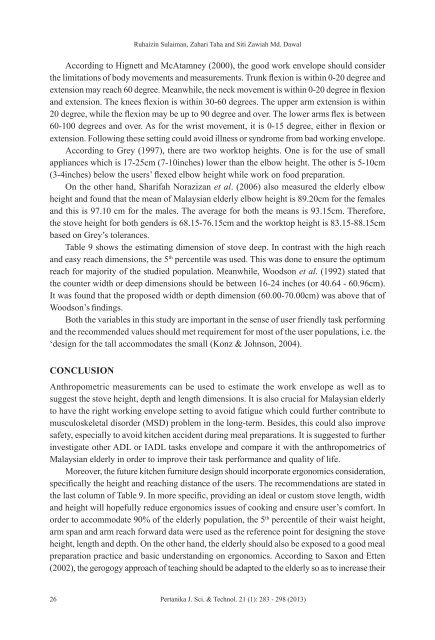JST Vol. 21 (1) Jan. 2013 - Pertanika Journal - Universiti Putra ...
JST Vol. 21 (1) Jan. 2013 - Pertanika Journal - Universiti Putra ...
JST Vol. 21 (1) Jan. 2013 - Pertanika Journal - Universiti Putra ...
You also want an ePaper? Increase the reach of your titles
YUMPU automatically turns print PDFs into web optimized ePapers that Google loves.
Ruhaizin Sulaiman, Zahari Taha and Siti Zawiah Md. Dawal<br />
According to Hignett and McAtamney (2000), the good work envelope should consider<br />
the limitations of body movements and measurements. Trunk flexion is within 0-20 degree and<br />
extension may reach 60 degree. Meanwhile, the neck movement is within 0-20 degree in flexion<br />
and extension. The knees flexion is within 30-60 degrees. The upper arm extension is within<br />
20 degree, while the flexion may be up to 90 degree and over. The lower arms flex is between<br />
60-100 degrees and over. As for the wrist movement, it is 0-15 degree, either in flexion or<br />
extension. Following these setting could avoid illness or syndrome from bad working envelope.<br />
According to Grey (1997), there are two worktop heights. One is for the use of small<br />
appliances which is 17-25cm (7-10inches) lower than the elbow height. The other is 5-10cm<br />
(3-4inches) below the users’ flexed elbow height while work on food preparation.<br />
On the other hand, Sharifah Norazizan et al. (2006) also measured the elderly elbow<br />
height and found that the mean of Malaysian elderly elbow height is 89.20cm for the females<br />
and this is 97.10 cm for the males. The average for both the means is 93.15cm. Therefore,<br />
the stove height for both genders is 68.15-76.15cm and the worktop height is 83.15-88.15cm<br />
based on Grey’s tolerances.<br />
Table 9 shows the estimating dimension of stove deep. In contrast with the high reach<br />
and easy reach dimensions, the 5 th percentile was used. This was done to ensure the optimum<br />
reach for majority of the studied population. Meanwhile, Woodson et al. (1992) stated that<br />
the counter width or deep dimensions should be between 16-24 inches (or 40.64 - 60.96cm).<br />
It was found that the proposed width or depth dimension (60.00-70.00cm) was above that of<br />
Woodson’s findings.<br />
Both the variables in this study are important in the sense of user friendly task performing<br />
and the recommended values should met requirement for most of the user populations, i.e. the<br />
‘design for the tall accommodates the small (Konz & Johnson, 2004).<br />
CONCLUSION<br />
Anthropometric measurements can be used to estimate the work envelope as well as to<br />
suggest the stove height, depth and length dimensions. It is also crucial for Malaysian elderly<br />
to have the right working envelope setting to avoid fatigue which could further contribute to<br />
musculoskeletal disorder (MSD) problem in the long-term. Besides, this could also improve<br />
safety, especially to avoid kitchen accident during meal preparations. It is suggested to further<br />
investigate other ADL or IADL tasks envelope and compare it with the anthropometrics of<br />
Malaysian elderly in order to improve their task performance and quality of life.<br />
Moreover, the future kitchen furniture design should incorporate ergonomics consideration,<br />
specifically the height and reaching distance of the users. The recommendations are stated in<br />
the last column of Table 9. In more specific, providing an ideal or custom stove length, width<br />
and height will hopefully reduce ergonomics issues of cooking and ensure user’s comfort. In<br />
order to accommodate 90% of the elderly population, the 5 th percentile of their waist height,<br />
arm span and arm reach forward data were used as the reference point for designing the stove<br />
height, length and depth. On the other hand, the elderly should also be exposed to a good meal<br />
preparation practice and basic understanding on ergonomics. According to Saxon and Etten<br />
(2002), the gerogogy approach of teaching should be adapted to the elderly so as to increase their<br />
26 <strong>Pertanika</strong> J. Sci. & Technol. <strong>21</strong> (1): 283 - 298 (<strong>2013</strong>)





